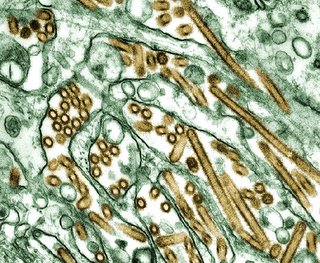
www.sfcdcp.org/index.cfm?id=87
So maybe BrooklynDodger(s) were too academic about the persistence infective avian flu material in the environment. Maybe the WHO public health message of "don't worry about chicken feces infected material after 7 days at body temperature or 35 days in a refrigerator" is the most practical expression, and, the Dodger hopes, science based.While researching that post, the Dodger found this picture on the San Francisco Department of Public Health website. There's no caption telling the Dodger which are the viral particles [dots or rods or both] or what the martrix is. The Dodger hopes it's public domain.
The digressive search lead to another set of numbers to muse about:
"Human Symptoms
Individuals exposed and infected by birds with avian H5N1 influenza usually developed symptoms within one week. This time between H5N1 infection and symptoms, or incubation period, is usually 2 to 4 days, but in some cases disease occurred up to 10 days after exposure. Symptoms include high fever, muscle aches, cough, sputum production and shortness of breath. Abdominal pain and diarrhea can also occur."
The Dodger assumes these are canonical numbers propagated by CDC and WHO. "Some cases 10 days after exposure" is at least a real observation, the known longest time, although the Dodger wonders how to figure that out if there are chickens in the yard. Maybe best defined as longest time after first known contact with a sick bird? last known contact?
"Usually 2 to 4 days" is a lot of weasel words; could they have said "half the cases develop within 3 days" and some observation on shorted time and the time when further cases are rare [which we guess to be time after removal of contact from sick birds, but what about infected material.]

No comments:
Post a Comment